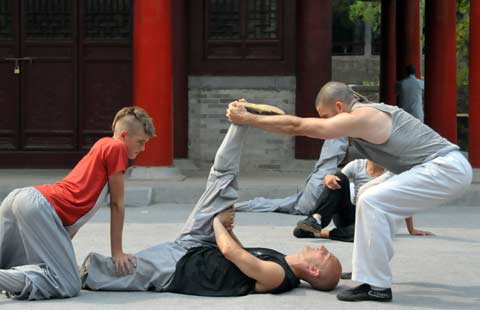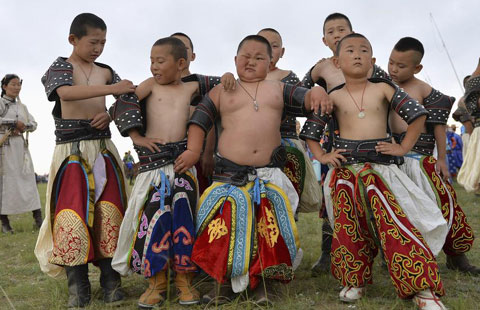'Shangri-la complex' stymies perception of Tibet
Updated: 2014-08-14 07:11
(Xinhua)
|
|||||||||||
In a children's clothes shop in downtown Lhasa, Choizong, 73, buys sportswear and a pair of football shoes for his six-year-old grandson.
The grandson loves playing football with his father at an indoor football field in the suburbs of the capital of southwest China's Tibet Autonomous Region.
"We mainly wore wool robes covered in patches in our childhood, " remembered Choizong, who is happy that his grandson was born in an era of rapid development in Tibet.
In 2013, the per capita net rural income in Tibet reached 6,578 yuan (1,067 U.S. dollars) and the per capita disposable income of urban residents exceeded 20,000 yuan. The average lifespan in Tibet has risen to the current 68 years from 35.5 years in the 1950s.
Most foreigners do not know Tibet was once one of the most impoverished places in the world. Before 1950, more than 95 percent of Tibet's population were serfs and 90 percent were illiterate.
Since British novelist James Hilton introduced the fictional "Shangri-la" to Western readers eight decades ago, foreign minds have often perceived Tibet as a mystical, harmonious paradise. They believe in a fantastical Himalayan region, cut off from the rest of the world, a permanently happy land where most inhabitants are meditative lamas clad in crimson robes, twirling prayer wheels and chanting mantras.
This Western "Shangri-la complex" hampers and limits rational understanding of the region.
In Chinese eyes, Tibet used to be a backwater with an inhumane serf system which craved development and civilization just like any other part of the world.
Hilton had never been to the places he wrote about. While journalists, film directors and politicians in his time portrayed Tibet as a heaven on Earth, the region itself was under the feudal system -- a society as cruel as, if not worse than, European society in the Dark Ages.
It was also a land where the average life expectancy for Tibetans was no more than 36 years and where wives who had extramarital affairs would have their noses and ears cut off for punishment.
"Despite the British invasion of Tibet in 1904, the West did not have the opportunity to understand Tibet," Alessandra Spalletta, China news editor of the Italian news agency AGI, told an ongoing forum on Tibetan development in Lhasa. "They started the mystification of Tibet while building the mythology of 'Shangri-la.'"
"Western people are fond of their own images of Tibet," she said, "rather than the real Tibet."
As some scholars point out, Tibet has become a "spiritual supermarket" for Westerners trying to find what they have lost from their own societies in the process of industrialization and modernization.
Some call Tibet the "last pure land on Earth" and want it to be immune from any development, afraid it might lead to destruction of Tibetan culture and annihilation of Tibetan Buddhism.
"Those people believe that Tibet should remain at a primitive stage for ever and Tibetans should always ride yaks and live in tents," Cui Yuying, vice head of the State Council Information Office, told the opening ceremony of the forum.
For the past half century, however, Tibet has been on an irreversible path of development and civilization, which complies with the general trend of the development of human society, Cui said.
Tibet's GDP has maintained double-digit growth for the past two decades. In 2013, the economy of Tibet reached 80.2 billion yuan (13 billion U.S. dollars).
"Tibet is in the best development period of its history," said Losang Jamcan, chairman of the Tibetan regional government. He stressed Tibet will never sacrifice its environment for economic growth.
"Tibet remains one of the places with the best environment in the world," said Jambae, head of the Tibet Environmental Protection Department. Water quality in rivers and lakes in Tibet has maintained high standards. Air quality is excellent or good in Lhasa and other major townships at most times of a year. The Chinese government plans to invest 15.5 billion yuan to protect Tibet's environment.
CURSE OF THE "SHANGRI-LA COMPLEX"
Obstructed by the "Shangri-la complex", many Western scholars have opted to study Tibet's history before the 20th century. Some even suggest that the history of Tibet after 1951, when the region was peacefully liberated, is not worth studying at all. Some Western media shun the economic achievements Tibet has made.
The notion of Shangri-la, created by Westerners, has been utilized by separatists endeavoring to split Tibet from China.
"Romanticization (of Tibet) is a part of the Dalai Lama's campaign for separatism," said Narasimhan Ram, chair of Kasturi & Son Limited and publisher of the Indian newspaper The Hindu.
He said that the Dalai Lama always talks about the beauty and isolation of the old Tibet rather than its backwardness and extreme poverty, taking advantage of the "Shangri-la complex."
Matevz Raskovic, a board member of the Confucius Institute, at the University of Ljubljana in Slovenia, told Xinhua that some Western media's skewed depiction of Tibet has reinforced the "Shangri-la complex" which hinders and limits rational understanding of Tibet.
"When you look at Tibet the way some Westerners perceive it, it always goes to religious issues," he said. "It should be the responsibility of journalists to expose other faces of Tibet, such as tourism and the cohabitation of diverse cultures."
Today's Top News
Chinese film fans mourn for star
Untested Ebola drugs ethical, says WHO
China demands more overseas crude
China halts some US pork imports
Over 1,000 auto firm under probe
Spanish priest with Ebola dies
Russian convoy heads to east Ukraine
UK launches 24-hour visa service in China
Hot Topics
Lunar probe , China growth forecasts, Emission rules get tougher, China seen through 'colored lens', International board,
Editor's Picks

|

|

|

|

|

|





